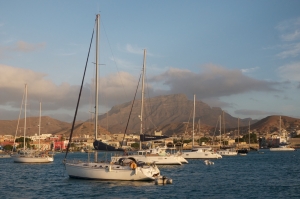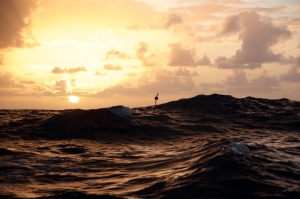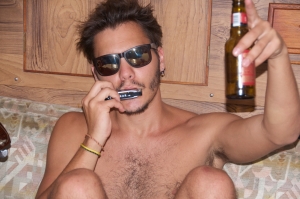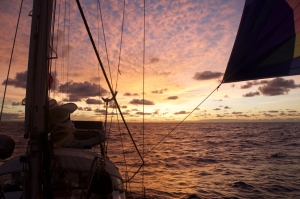
The Trans-Atlantic
We are starting one of our childhood’s dreams: crossing the Atlantic on a sailing boat. If we were told that it was going to be with a 100% novice crew, I don’t think we would have believed it. But we’ve built this trip from the beginning and are ready for it.
Here we are, at the dawn of our crossing, facing this large Atlantic Ocean. Sails are all repaired; water and food on board, the Trade Winds are regular and blowing between 15 and 20 knots. All we have to do is to say goodbye to our friends in Capo Verde and set sail. Our program: 2200 nautical miles to go, cap to 288°, direction is Saint Martin in the Antilles. We are 4 crewmembers on board of the Williwaw, which is perfect to organise our night shifts. We are leaving the Mindelo coast on December 1st at 9am. Sailing south of the Santo Antao is complex because of the Venturi effect between the two islands and Williwaw goes at a fast pace, as if it wanted to show us its eagerness to cross this ocean.
The crew adjusts the sails, starboard tack, a reef out of the mainsail, the genoa is fixed at 120°, the pilot takes the helm and won’t let it go for a while.
Our first days are a navigation delight. The wind blows between 15 and 20 knots and comes from north, which means that we are following Williwaw’s favourite angle. It went at more than 7 knots average during 4-5 days. The only problem is the swell, coming from ¾ behind, which cause the boat to roll a lot. The more sensitive ones take pills and the others play with equilibrium to prepare the meals. The night shifts come one after another and all is fine, few rainy hours but nothing too difficult. We take reefs and remove them following the winds, as we need to take care of the equipment. Every day, we change shifts: 9pm – midnight, midnight-3am, 3am- 6am and 6am-9am. I personally prefer the 6am shift where you can enjoy a fantastic sunrise every time.
After the 5th day, the wind calms down and does not overtake 17-18 knots. We can now use the spinnaker. We have waited a long time to be able to enjoy this large headsail; we barely used it since our departure from Toulon. As we want to preserve the sail and the crew, we only use it during the day. We don’t want to take any risk. Williwaw still goes at 6 knots average – for our great pleasure. We are planning to arrive on December 14th or 15th, which is an excellent timing for a trans-Atlantic crossing. But that was the plan before the lack of wind and various damages. Neptune can’t be good with us all the time despite our sacrifices. In the night of December 10th, our genoa is out when suddenly the rail that fixes it to the mast breaks. The boom is nearly in the water and the sail can hardly be controlled. Nicolas calls for help and the crew ends up removing the lot out of the water in pyjamas. We put the sail and boom aside, along the walkway. Damages assessment will be for tomorrow. The following morning, damages are serious. The boom is twisted and 17 rivets are broken on the lower part. Result: we can’t use the spinnaker anymore. Too bad, the wind is losing its strength.
We will therefore finish our crossing by using the gennaker, a sail that works best with crosswind but which we will use with tailwind. A direct consequence is that the boat slows down. During the last 4-5 days, the wind is weak and we are going at a daily pace of 2-3 knots average and are using the motor at night to charge batteries and move forward a bit.
On the fishing side, we are bad, very bad… There are a lot of algae that float on our route, the Sargasso, following the current from Cape Verde to the Antilles, and we catch all of those, much more than fish. One night, we catch a silver scabbard fish. It’s a long fish, very slim, that does not have a lot of flesh; therefore, it will go back to the ocean.
At the end of the crossing, we catch two “dolphin-fish” but unfortunately they will win the “let’s get them out-of the water” fight. Outcome: one broken line, two lost lures, three catch back in the water and four frustrated stomachs.
On December 17th in the morning, we finally see the land. It is strange to see civilisation after 16 days spent in the middle of the ocean. Our first steps back on land will guide us to a good burger. We must now repair the damages and prepare our actions for Central America. We also want to have a look around this beautiful Saint Martin’s island for Christmas and have some rest after those two fantastic weeks of Atlantic- crossing.
Capt’N Thomas








































